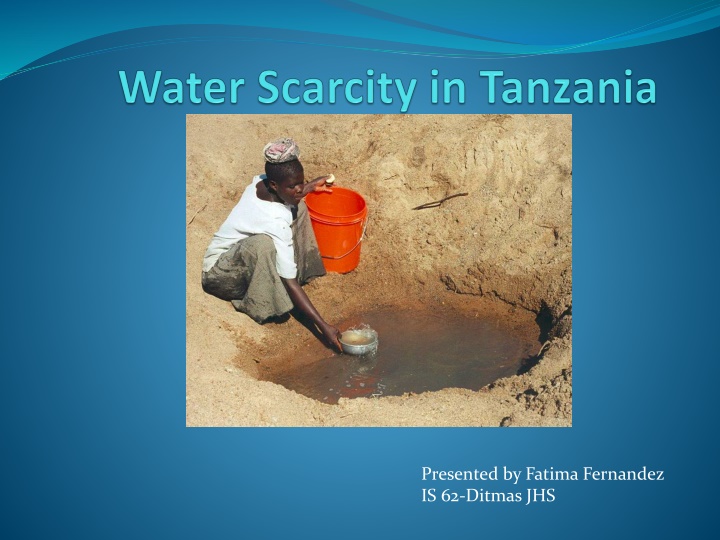
Addressing Water Scarcity in Tanzania: Solutions and Policy Evaluation
Explore the challenges of water scarcity in Tanzania and discover potential solutions through policy evaluation and innovative water filtration systems. Learn about the causes, impacts, and efforts by global organizations to tackle this pressing issue affecting millions worldwide.
Download Presentation

Please find below an Image/Link to download the presentation.
The content on the website is provided AS IS for your information and personal use only. It may not be sold, licensed, or shared on other websites without obtaining consent from the author. If you encounter any issues during the download, it is possible that the publisher has removed the file from their server.
You are allowed to download the files provided on this website for personal or commercial use, subject to the condition that they are used lawfully. All files are the property of their respective owners.
The content on the website is provided AS IS for your information and personal use only. It may not be sold, licensed, or shared on other websites without obtaining consent from the author.
E N D
Presentation Transcript
Presented by Fatima Fernandez IS 62-Ditmas JHS
PPA-Policy Steps Define the problem 1. 2. Gather the evidence 3. Identify the cause 4. Evaluate the policy 5. Develop solution 6. Select the best solution
What is water Scarcity Water scarcity or lack of safe drinking water is one of the world's leading problems affecting more than 1.1 billion people globally, meaning that one in every six people lacks access to safe drinking water
Defining the Problem Fact about TANZANIA Population: 47,780,000 47% lack access to water 88% lack access to sanitation 33.4% live below poverty line Every year about 200,000 children after contracting waterborne disease.
Identify the Cause What are some of the problem that affect the water supply in Tanzania? Dry Great Ruaha River - Most of the country is too dry and scarce of water to support agriculture
Activity Calculate Personal Water Use Have students use the below chart to estimate their daily water use. Directions: Fill out column A with the number of times you do each action in one day. Then, multiply columns A and B to determine the estimated gallons of water you use per day for each activity.
EVALUATE POLICY Written Response : Use the Evaluate Poli cy worksheet a. Several trans-national organizations, including the United Nations and The World Bank, are currently addressing the water crisis. Select one to research and report out on how they are tackling this is https://encrypted-tbn3.gstatic.com/images?q=tbn:ANd9GcSkvK35Lc0u6aWslpe6pVjoFU6WVOt_fTFJW5Ldc2zRunnFqQNF
Develop Solutions Look up recent articles on water filtrations systems and other water innovations currently being developed and used in the Tanzania. What new systems and innovations seem the most promising, and most practical, to be used in the nations currently suffering the water crisis? Use the select best solution worksheet .
Select best solution FEASIBILITY EFFECTIVENESS HIGH MEDIUM LOW HIGH MEDIUM LOW
The Water Walk Class Activity- Explain to students that they will participate in an activity to learn how the water crisis affectswomen and children around the world.
Reflection: http://www.teachertube.com/viewVideo.php?video_id=242134 http://www.unwater.org/fileadmin/templates/WWD-2014/images/wwwd-logo.png
